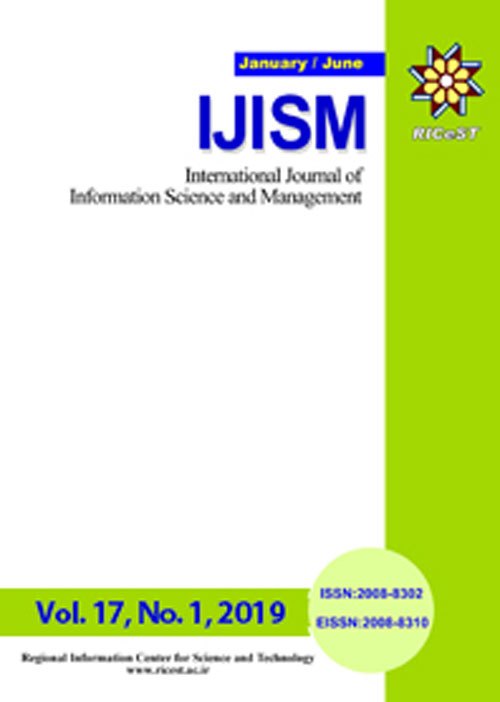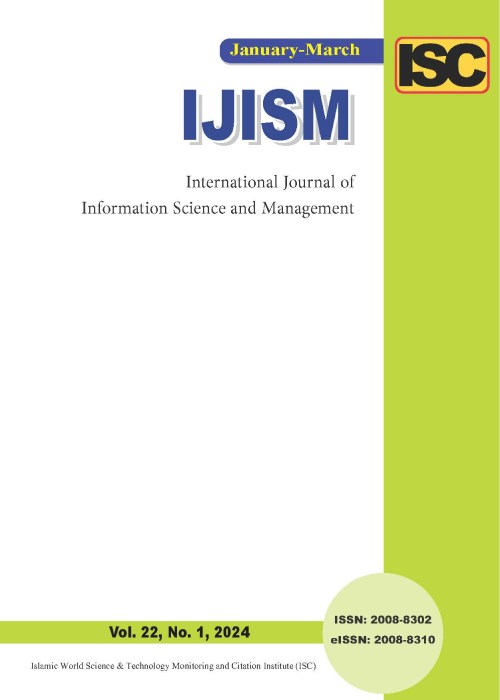فهرست مطالب

International Journal of Information Science and Management
Volume:17 Issue: 1, Jan-Jun 2019
- تاریخ انتشار: 1397/12/25
- تعداد عناوین: 8
-
-
Pages 1-16The aim of the study was to improve Persian search engines’ retrieval performance by using the new measure. In this regard, consulting three experts from the Department of Knowledge and Information Science (KIS) at Ferdowsi University of Mashhad, 192 FUM students of different degrees from different fields of study, both male and female, were asked to conduct the search based on 32 simulated work tasks (SWT) on the selected search engines and report the results by citing the related URLs. The Findings indicated that to measure recall, one does not focus on how documents are selecting, but the retrieval of related documents that are indexed in the information retrieval system database is considered While to measure comprehensiveness, in addition to considering the related documents' retrieval in the system's database, the performance of the documents selecting on the web (performance of crawler) was also measured. At the practical level, there was no strong correlation between the two measures (recall and comprehensiveness) however, these two measure different features. Also, the test of repeated measures design showed that with the change of the measure from recall to comprehensiveness, the search engine’s performance score is varied. Finally, it can be said, if the study purpose of the search engines evaluation is to assess the indexer program performance, the recall use will be suggested while, if its purpose is to appraise the search engines to determine which one retrieves the most relevant documents, the comprehensiveness use will be proposed.Keywords: Recall, Comprehensiveness, Evaluation of Information Retrieval Systems, Search Engines.
-
Pages 17-31This article presents an empirical evaluation to investigate the distributional semantic power of abstract, body and full-text, as different text levels, in predicting the semantic similarity using a collection of open access articles from PubMed. The semantic similarity is measured based on two criteria namely, linear MeSH terms intersection and hierarchical MeSH terms distance. As such, a random sample of 200 queries and 20000 documents are selected from a test collection built on CITREC open source code. Sim Pack Java Library is used to calculate the textual and semantic similarities. The nDCG value corresponding to two of the semantic similarity criteria is calculated at three precision points. Finally, the nDCG values are compared by using the Friedman test to determine the power of each text level in predicting the semantic similarity. The results showed the effectiveness of the text in representing the semantic similarity in such a way that texts with maximum textual similarity are also shown to be 77% and 67% semantically similar in terms of linear and hierarchical criteria, respectively. Furthermore, the text length is found to be more effective in representing the hierarchical semantic compared to the linear one. Based on the findings, it is concluded that when the subjects are homogenous in the tree of knowledge, abstracts provide effective semantic capabilities, while in heterogeneous milieus, full-texts processing or knowledge bases is needed to acquire IR effectiveness.Keywords: distributional semantics, semantic similarity, textual similarity, effectiveness, information retrieval, MeSH
-
Pages 33-46Heterogeneous data in all groups are growing on the web nowadays. Because of the variety of data types in the web search results, it is common to classify the results in order to find the preferred data. Many machine learning methods are used to classify textual data. The main challenges in data classification are the cost of classifier and performance of classification. A traditional model in IR and text data representation is the vector space model. In this representation cost of computations are dependent upon the dimension of the vector. Another problem is to select effective features and prune unwanted terms. Latent semantic indexing is used to transform VSM to orthogonal semantic space with term relation consideration. Experimental results showed that LSI semantic space can achieve better performance in computation time and classification accuracy. This result showed that semantic topic space has less noise so the accuracy will increase. Less vector dimension also reduces the computational complexity.Keywords: Persian Text Classification, Vector Space Model, Latent Semantic Indexing (LSI)
-
Pages 47-57Retrieving relevant information on the Internet and identifying the related information to the real needs are not an easy task for many users. So the main objective of this study was to evaluate the effect of search strategies on the relevance of retrieved information in domestic article databases. Considering the nature of the subject, this was an applied descriptive-survey research. Statistical population consists of all domestic article databases, from which the MAGIRAN, IRANDOC, NOORMAGZ and the Regional Information Center for Science and Technology (RICeST) were selected as samples. To test the hypotheses, one-way analysis of variance (ANOVA) and Tukey’s post-hoc test were computed using SPSS statistical software version 22. The study’s findings showed that there were significant differences between relevance of the information retrieved from different databases based on different search strategies. It was found that, using simple search had the highest relevance. Moreover, using the AND, NOT and OR operators, took the lower ranks respectively. Using the time limiter had the lowest relevance in information retrieval. There were also significant differences between the relevance of information retrieved from different databases, and the NOORMAGZ database, the RICeST, MAGIRAN and IRANDOC; respectively had the most relevant retrievals. Using different search strategies can affect the relevance of the information retrieved from an article database. Therefore, acquiring these strategies and using each one in the right situation can improve the relevance of the retrieved information.Keywords: Information Retrival, Relevance, Search Strategy, Article Database, Magiran, IRANDOC, Noormagz, RICeST
-
Pages 59-72Early altmetric investigations have focused on measuring the correlations between citation and altmetrics to partially validate the new metrics articles (Thelwall, Haustein, Larivière, & Sugimoto, 2013; Priem, & Hemminger, 2010; Costas, Zahedi, & Wouters, 2014). The main aim of this research is to study the relationship between citation count indicator and almetrics or the new metrics in social -web of medical sciences journals. Present research is an applied research and the method used for doing it, is descriptive from correlation type which test relationship between citation count indicators and almetrics or the new metrics in social web. 111 medical sciences journals which have the highest SJR in Scopus databases were selected as research population from Scimago Journal Ranking (SJR) 2013-2014. Altmetrics—alternative metrics usually based on data from the social web which could be seen as a particularly promising approach in efforts to find appropriate measures for assessing Medical Science Journals were extracted through altmetrics.com. Research results show that there is significant correlation between Medical science journals altmetrics tools like F1000, Mention, Facebook, and News and their citation Numbers. There is no significant correlation between Medical science journals altmetrics tools like Reddit, Blog posts, Google plus, Tweets and their citation numbers. Structural equation modeling also shows the same results.Keywords: Altmetrics, Scientometrics, Citations counts, F1000, Mentions, G+, Facebook
-
Pages 73-82Assessment of students’ ability to cope with a new educational system and Information technology in Islamic Higher education-based setting may provide information with which to develop effective interventions to improve the process of information seeking behavior in the future. This study aims to identify the current status of information seeking behavior’s process based on the new educational system and Information technology in Islamic Higher education. The conceptual model which was used in this study included five stages as follows: Access to Information Resources, Using Information Resources, Evaluating Information Resources, Crisis situation, and Research skills. In order to assess validity (content), the views of Knowledge and Information Sciences professors and expert’s assessment was used and the questionnaire reliability was obtained between 0.684 and 0.754 by Cronbach alpha. In order to fulfill the aim of the study, 323 Female Students who participated in this study were randomly selected were 215 in Fars and 108 in Bushehr Province holders in 1394-1395 Academic years at Fars and Bushehr Islamic Higher education. Data collection tool in this study was the questionnaire. The Wilcoxon signed-rank test used to analyse data. The results showed that Library in Islamic Higher education, Printing Book, Authority, and learning in the classroom or training at the workshop, are so important elements for Islamic Higher education students. On the other hand there was no significant difference between criteria regarding crisis situation.Keywords: Education System, Information Technology, Information Seeking Behavior, Islamic Higher Education System, Fars Province, Bushehr Province
-
Pages 83-95Abstracts are regarded as valuable tools in assessing the relevance of documents during information retrieval. The determination of abstract compliance based on international standards is one of the methods which can be used for generating qualified information, reducing costs and establishing aligned coordination with international standards. Further, ANSI/NISO Z39.14 standard is one of the international standards presented by NISO committee which its final amendment was published in March 2015 and proposed some principles in terms of content and structural elements of different sources like theses. For this purpose, the present study aimed to evaluate the abstracts of Persian theses in different educational levels with ANSI/NISO Z39.14 standard at Shahid Beheshti University of Medical Sciences (SBMU) during 2010-2014. 386 Persian abstracts were selected from among the abstracts in master’s theses, PhD dissertations, Medical Doctorate(MD) and specialized medicine theses at different schools. The standard texts of ANSI/NISO Z39.14 (R2015) were used as the instrument including 15 structural and 5 content elements. Results indicated that there was a significant difference between the consistency of structural and content elements of the standards among the abstracts of the selected theses at different educational levels in different schools. The results suggest that an instructional and a coherent model should be developed, based on international and latest edition standards such as ANSI/NISOZ39.14 guideline for abstracts which are necessary to be followed by all centers in order to improve the style of writing abstracts.Keywords: Theses Abstracts, ANSI, NISO Z39.14 (R2015) Standards, Information Retrieval, Shahid Beheshti University of Medical Sciences
-
Pages 97-107This study tries to investigate the rate of meeting goals of Public Libraries 2025 Vision and compare this situation in 2025 with that of in 2010 and 2015. So, different situations in three different years, namely, 2010, 2015, and 2025 have been compared by taking into account the indicators regarding 2025 vision document using related data taken from public libraries in each province separately. The findings show that the current situation of the five indicators studied in 2025 has significant difference compared with that of in 2015. Also a comparison between the current situation in 2015 and a past one in 2010 shows a significant difference and an increase in them in terms of three indicators, space, resources and employee. It should be mentioned that there are not a significant difference between these two years, 2010 and 2015, regarding two indicators, book borrowing and membership.Keywords: Public Libraries, Iran, Public Libraries Foundation, 2025 Vision Goals


